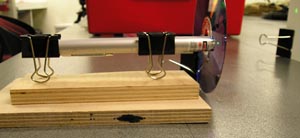
A laser mount made with binder clips.
Making the small, large
Introduction
A small pattern will create a large diffraction pattern when a laser is shone through it.
Material
Assembly
Mount the white screen on a wall, or table.
Mount the laser, use binder clips.
By pushing the laser into the binder clips you can use the binder
clip to push on the laser switch to turn it on.

A laser mount made with binder clips.
To Do and Notice
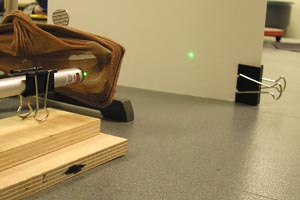
Notice the diffraction pattern made by stockings.
Hold the nylon stocking about 20 cm from the white
screen on the wall.
Shine the laser through the nylon stocking toward a white screen on
the wall.
Notice the diffraction pattern from the stocking
on the wall.
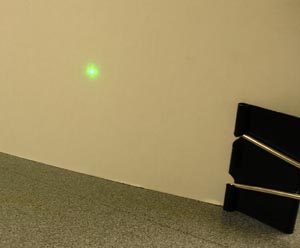
The diffraction pattern of the stockings I used had concentric
circles spanning more than a centimeter in radius.
Measure the diameter of the diffraction pattern.
Stretch the nylon stocking while the laser is shining through it. Notice that as the pattern of the stocking is stretched larger, the diffraction pattern becomes smaller in the direction of the stretch
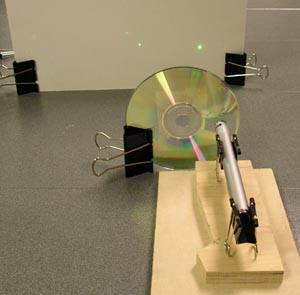
Shine a laser through a CD which has had the aluminizing
scraped off.
Hold the compact disk 20cm from the screen, shine the laser straight at the CD so that the laser beam bounces onto the screen. Notice the spread of the light dots created by the tiny pattern of pits on the CD.
Optional, the aluminum coating can be scraped off some CD's scrape the coating off a tiny bit of the CD and shine the laser through the CD. (In particular it is easy to remove the coating from GQ brand compact disks.)
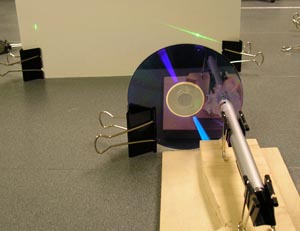
Shine a laser through a DVD, notice how the diffraction pattern is
larger than the pattern from a CD.
Reflect the laser from a DVD onto the wall. The pattern of pits on the DVD has 1/2 the spacing as the pattern on a CD.
Notice how the laser dots are spread much further by the DVD.
Optional, split the DVD, look along the edge then scrape off some of the aluminizing. Shine the laser through the DVD. (To split the DVD sand paper 1 mm from the edge this will expose the edges of the layers, carefully use a knife to split the layers apart.)
What's Going On?
When laser light scatters off an object pattern a diffraction pattern is created.
If the object pattern changes over short spatial distances then the diffraction pattern will be widely spread. If the object pattern changes over long spatial distances then the diffraction pattern will change over short distances.
The spacing of the changes in an object pattern is inversely related to the spacing of the changes in the diffraction pattern.
Shining a laser through an object can be used to study small scale patterns in the object.
Math Root
The pattern of an object in space can be expressed as the sum of sinewave patterns.
Light is diffracted at an angle from each sinewave pattern.
Short wavelength sinewaves diffract light through large angles and so make large patterns on a screen at a constant distance.
The diffraction pattern on a distant screen is the two dimensional spatial fourier transform of the original object pattern.
|
Scientific Explorations with Paul Doherty |
|
25 November 2005 |